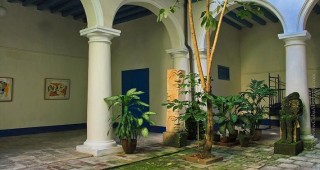
Parque Arqueológico de la Maestranza LH  2
2
By the 1700s, Havana boasted an artillery factory for the manufacture and repair of weapons and ammunition. The factory was demolished and a “castle” was the built for the Police. This archeological s …

Avenida de Carlos III (Ave. Salvador Allende) LH  2
2
This street was built by order of Governor Miguel de Tacón in 1836 and connects the intersection of Reina and Belascoaín streets to the Castillo del Príncipe. It was originally named Paseo de Tacón. L …

Casa Oswaldo Guayasamín LH  2
2
This institution honors Ecuadorian painter Oswaldo Guayasamín (1919-1999), a dedicated socialist, supporter of the Cuban Revolution, and close friend to Fidel Castro. It’s located in an 18th-century m …

Museo del Naipe Marqués de Prado Ameno LH  2
2
Opened on May 2, 2001, the small yet immensely impressive Playing Card Museum occupies the ground floor of the Casa del Marqués de Prado Amero, dating from the 17th century and the oldest building in …

Hotel Presidente LH  2
2
This is Havana’s first skyscraper and was inaugurated on December 28, 1928. It took its name from the street it is situated in and is the only hotel that features Cuba’s coat of arms on its façade. It …
 ModernROOMS: 158Calzada #110 esquina a G (Avenida de los Presidentes)
ModernROOMS: 158Calzada #110 esquina a G (Avenida de los Presidentes) 
Clock Tower LH  2
2
Between 1921 and 1924, a clock tower was built on Fifth Avenue. It was designed by New Yorker John H. Duncan, one of the architects that contributed to the layout of the avenue and who also designed t …

Iglesia y Convento de Santa Catalina de Siena LH  2
2
The Convent of the Dominican Sisters of Saint Catherine of Siena moved from its former site in Old Havana to a new and prime location in El Vedado on May 13, 1918. The construction of the convent and …
 EclecticPaseo entre 23 y 25
EclecticPaseo entre 23 y 25 
Memorial a Julio Antonio Mella LH  1
1
Across from the Universidad de La Habana is this memorial, often used to make concerts and for political or student rallies. It holds the ashes of Julio Antonio Mella, a young student leader and found …

Museo de Orfebrería LH  1
1
The museum displays a collection of silver walking sticks, swords and other items of metalwork by Cuban silversmiths from the 15th-20th centuries. Especially interesting are the pieces from the coloni …

Compañía Cubana de Electricidad LH  1
1
Made with reinforced concrete and constructed entirely as an office building, it now houses the Ministerio de la Industria Básica (Ministry of Basic Industry). Rich materials such as marble, granite, …
 ModernCarlos III (Avenida Salvador Allende) #606 entre Oquendo y Soledad
ModernCarlos III (Avenida Salvador Allende) #606 entre Oquendo y Soledad 